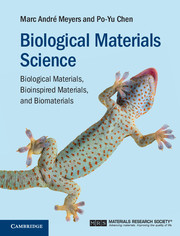Book contents
- Frontmatter
- Epigraph
- Contents
- Preface
- List of Boxes
- 1 Evolution of materials science and engineering: from natural to bioinspired materials
- Part I Basic biology principles
- 2 Self-assembly, hierarchy, and evolution
- 3 Basic building blocks: biopolymers
- 4 Cells
- 5 Biomineralization
- Part II Biological materials
- Part III Bioinspired materials and biomimetics
- References
- Index
4 - Cells
from Part I - Basic biology principles
Published online by Cambridge University Press: 05 August 2014
- Frontmatter
- Epigraph
- Contents
- Preface
- List of Boxes
- 1 Evolution of materials science and engineering: from natural to bioinspired materials
- Part I Basic biology principles
- 2 Self-assembly, hierarchy, and evolution
- 3 Basic building blocks: biopolymers
- 4 Cells
- 5 Biomineralization
- Part II Biological materials
- Part III Bioinspired materials and biomimetics
- References
- Index
Summary
Introduction
The cell is one of the most complex machines known. Life is associated with cells, and there are researchers who feel that we will never be able to create a cell. The analogy with a Boeing 747 illustrates this. This airplane, one of the most complex machines ever built, has approximately six million parts (including rivets, screws, etc.), whereas the typical mammalian cell has 10 000 different proteins (~50 000 of each), for a total of 500 million parts (P. LeDuc, Carnegie-Mellon University, private communication). Added to these are the ATP molecules, of which there are approximately six billion per cell. Thus, the task of reproducing a cell, close to 100 Boeings, in a volume of approximately hundreds of cubic micrometers, is daunting.
How was the first cell formed? This is indeed the definition of life, because a cell can undergo mitosis, a process by which it generates another cell. There are different hypotheses, none of which have yet been substantiated.
Astrobiology, a new field of study, explores the possibility of life in outer space; it is possible that life could have been transported to earth embedded in meteorites.
The classic Miller–Urey experiments were conducted, in which Miller and Urey created a “primeval soup” and passed a high current through it, synthesizing more complex organic molecules. However, there is evidence that the early atmosphere was quite different. As an encouragement to graduate students, Miller was a rather testy one who asked Urey, then already a well-known professor, to set up such an apparatus. Reluctantly, Urey agreed and, to his surprise, the success came early and easily. This paper had far-reaching consequences. Alas, Miller never got a Nobel Prize for his experiment, but Urey did. Another warning for graduate students.
The vent holes in the bottom of the ocean. It has been proposed these vent holes could have given rise to life.
Organisms are classified into prokaryotic and eukaryotic types. Prokaryotes are all unicellular and are divided into archaea and bacteria. Eukaryotes are the other organisms, including us, homo sapiens. Prokaryotic cells are simpler and smaller than eukaryotic cells, and they do not have a nucleus. The eukaryotic cells have diameters 10–100 µm, whereas the prokaryotic cells have diameters of 1–10 µm. Whereas bacteria are unicellular, humans contain 1013 cells. As a comparison, there are approximately 1010 humans on this planet. These cells control all the processes in our body.
- Type
- Chapter
- Information
- Biological Materials ScienceBiological Materials, Bioinspired Materials, and Biomaterials, pp. 102 - 128Publisher: Cambridge University PressPrint publication year: 2014



